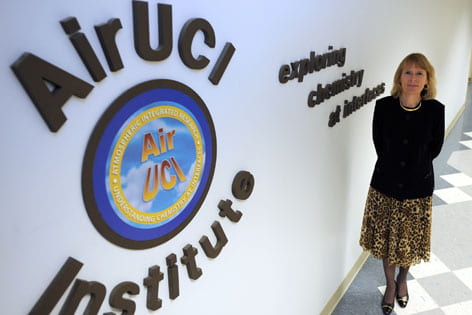Chemists discover ozone-boosting reaction
It’s a recipe for choking smog. Burn tons of fossil fuels. Pump those chemicals into the air where they react on surfaces of buildings and roads. A result is the creation of photochemical smog-forming chlorine atoms, UC Irvine scientists report in a new study.

It’s a recipe for choking smog.
Burn tons of fossil fuels. Pump those chemicals into the air where they react on surfaces of buildings and roads. A result is the creation of photochemical smog-forming chlorine atoms, UC Irvine scientists report in a new study.
Under extreme circumstances, this previously unknown chemistry could account for up to 40 parts per billion of ozone – nearly half of California’s legal limit on outdoor air pollution. This reaction is not included in computer models used to predict air pollution levels and the effectiveness of ozone control strategies that can cost billions of dollars.
Ozone can cause coughing, throat irritation, chest pain and shortness of breath. Exposure to it has been linked to asthma, bronchitis, cardiopulmonary problems and premature death.
“Realistically, this phenomenon probably accounts for much less than 40 parts per billion, but our results show it could be significant. We should be monitoring it and incorporating it into atmospheric models,” said Barbara Finlayson-Pitts, Distinguished Professor of Chemistry and lead author of the study. “We still don’t really understand important elements of the atmosphere’s chemistry.”
Study results appear the week of July 20 in the Proceedings of the National Academy of Sciences.
When fossil fuels burn, compounds called nitrogen oxides are generated. Previously, scientists believed these would be eliminated from the atmosphere upon contact with surfaces.
But UCI scientists discovered that when nitrogen oxides combine with hydrochloric acid from airborne sea salt on buildings, roads and other particles in the air, highly reactive chlorine atoms are created that speed up smog formation.
Hydrochloric acid also is found indoors in cleaning products. When it interacts with nitrogen oxides from appliances such as gas stoves, chlorine compounds form that cause unusual chemistry and contribute to corrosion indoors.
The study was undertaken by scientists involved with AirUCI, an Environmental Molecular Sciences Institute funded by the National Science Foundation. UCI’s Jonathan Raff conducted experiments; Bosiljka Njegic and Benny Gerber made theoretical predictions; and Wayne Chang and Donald Dabdub did the modeling. Mark Gordon of Iowa State University also helped with theory.
Said Finlayson-Pitts: “This is a great example of how our unique collaborative group can produce some really great science.”